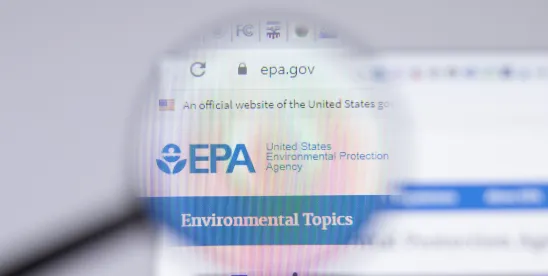As environmental concerns continue to take center stage, more and more companies are finding themselves facing scrutiny from the U.S. Environmental Protection Agency (EPA). As a result, from a risk management perspective, environmental compliance is more important than ever in 2024—and this is likely to remain the case for the foreseeable future.
What does this mean for companies whose operations have (or have the potential to have) environmental impacts? The short answer is that they need to make EPA compliance a priority. They must proactively address all areas of concern, and they must be prepared to demonstrate their proactive efforts to the EPA if necessary.
The EPA’s enforcement arm is extremely active, and several offices within the agency are tasked with uncovering and addressing environmental regulations violations. As discussed below, many federal environmental laws include criminal enforcement provisions as well, and the EPA regularly works with the U.S. Department of Justice (DOJ) to pursue criminal charges when warranted.
7 Keys to Avoiding EPA Scrutiny in 2024 (and Beyond)
With all of this in mind, what do company owners and executives need to know in order to avoid triggering EPA scrutiny in 2024 (and beyond)? Here are seven tips for effectively manage environmental compliance in today’s world:
1. Thoroughly Assess the Company’s Environmental Compliance Obligations
The EPA enforces numerous federal environmental statutes, and it has promulgated an extraordinarily long, dense, and complicated set of regulations under these statutes. The EPA enforces a number of environmentally focused Executive Orders (EOs) as well. As a result, for all companies, the first step toward implementing an effective EPA compliance program is determining which laws, regulations, and EOs apply. Here are just some of the most common examples:
- Clean Air Act (CAA) compliance
- Clean Water Act (CWA) compliance
- Comprehensive Environmental Response, Compensation, and Liability Act (CERCLA) compliance
- Endangered Species Act (ESA) compliance
- Energy Independence and Security Act (EISA) compliance
- Federal Insecticide, Fungicide, and Rodenticide Act (FIFRA) compliance
- Food Quality Protection Act (FQPA) compliance
- Marine Protection, Research, and Sanctuaries Act (MPRSA) compliance
- Resource Conservation Recovery Act (RCRA) compliance
- Safe Drinking Water Act (SDWA) compliance
- Toxic Substances Control Act (TSCA) compliance
- Environmental Executive Order (EO) compliance
Determining applicability requires an in-depth understanding of each source of authority’s focus and scope. As a result, assessing a company’s environmental compliance obligations generally involves engaging experienced outside EPA counsel.
2. Develop Custom-Tailored Environmental Compliance Policies, Procedures, and Protocols
Of course, simply understanding a company’s compliance obligations is not enough. To effectively manage environmental compliance, companies must develop environmental compliance policies, procedures, and protocols that are custom-tailored to their operations and facilities. These should be sustainable practices that will increase operational efficiency and reduce costs and waste.
This, too, involves working with experienced EPA counsel. To establish and maintain EPA compliance, companies may need to take a variety of different steps. Depending on the specific environmental risks a company’s operations present (or may present), these steps may include:
- Applying for a license, permit, or registration with the EPA
- Passing EPA inspections
- Restricting or preventing the discharge of contaminants or pollutants
- Issuing notifications to consumers and/or the EPA
- Promptly remediating spills and other exposure events
These are just a handful of numerous possibilities. While managing EPA compliance will be relatively straightforward for some companies, for others it can be a substantial undertaking. In both cases, developing custom-tailored policies, procedures, and protocols is a critical step toward effective regulatory compliance management.
3. Prioritize Environmental Compliance as an Element of Corporate Culture and Responsibility
Managing EPA compliance is not a one-time event. In other words, while developing custom-tailored policies, procedures, and protocols is a critical step toward effective compliance management, it is ultimately just one step in an ongoing process.
To effectively manage EPA compliance, companies need to take a top-down approach. They need to prioritize environmental compliance as an element of corporate culture and responsibility, and they need to make clear that personnel at all levels of the organization play an important role in protecting both the environment and the company. Lack of understanding and commitment at the executive level is a red flag for the EPA, and ineffective implementation of a company’s EPA compliance program can significantly increase its risk of both committing violations and facing enforcement.
4. Monitor and Audit Environmental Compliance
Another critical aspect of effectively managing a company’s environmental compliance-related risk is internally assessing compliance on an ongoing basis. Once a company has implemented its custom-tailored policies, procedures, and protocols, it must determine whether these are functioning as intended. While they should be, companies cannot afford to assume that this is the case. Ineffective training, oversights during implementation, changes in a company’s operational procedures, and various other issues can lead to compliance failures despite the implementation of an otherwise well-suited EPA compliance program.
Internally assessing compliance has two main components: (i) continuous monitoring, and (ii) periodic auditing. Companies should have safeguards in place that are designed to detect material violations when they occur. Companies must also conduct compliance audits at least annually to perform a deep-dive analysis of the efficacy of their compliance efforts. Crucially, if a company’s monitoring or auditing efforts uncover a violation of environmental rules, the company must then respond appropriately—and it must do so as efficiently as possible.
5. Generate and Store Environmental Compliance Documentation as a Matter of Course
When facing scrutiny from the EPA, being prepared to affirmatively demonstrate a company’s good-faith environmental compliance efforts is essential. In almost all cases, this is both the most effective and the most efficient way to resolve an EPA inquiry. Doing so requires clear and comprehensive documentation of the company’s ongoing compliance efforts, including its efforts to monitor, audit, and enforce compliance.
This means that companies need to generate and store environmental compliance documentation as a matter of course. By building documentation into their procedures and protocols, companies can do this efficiently and in a manner that facilitates demonstrating compliance to the EPA when necessary.
6. Respond Promptly (and Appropriately) to Information Requests and Other Inquiries
Companies can hear from the EPA under a variety of different circumstances. While different types of inquiries call for different types of responses, in all cases, a prompt and informed response is critical.
Once the EPA initiates an inquiry, it isn’t simply going to go away. Delay tactics will raise red flags; and, in the meantime, the EPA will be continuing its investigative and enforcement efforts. As part of their EPA compliance policies and procedures, companies should establish a step-by-step process for responding to the EPA in various scenarios. In most scenarios, the first step in this process will be engaging the company’s outside EPA counsel to provide guidance.
7. Update the Company’s Environmental Compliance Program as Necessary
Just as companies need to monitor their EPA compliance efforts on an ongoing basis, they must also monitor for any changes that necessitate updates to their environmental compliance programs. These changes could involve either: (i) changes in the environmental legislation; or, (ii) changes in the company’s operations that present new environmental compliance risks. In both cases, prompt action is key, as the EPA expects companies to consistently maintain comprehensive compliance.
Failing to Effectively Address Environmental Compliance: What Are the Risks?
Ideally, companies will maintain effective EPA compliance programs, and this means that they won’t have to worry about the risks of noncompliance. But, let’s say a company doesn’t do everything that is required. If the EPA has grounds to pursue enforcement, what are the risks involved?
Depending on the circumstances, the risks of environmental noncompliance can include:
- Loss of License, Permit, or Registration – Companies may need to obtain a license, permit, or registration from the EPA in various scenarios. Failure to comply with the terms of licensure, permitting, or registration can lead to temporary suspension or permanent revocation.
- “No Sale” Orders, Injunctions, and Other Administrative Remedies – The EPA also has the authority to impose “no sale” orders, injunctions, and other administrative remedies as necessary. If a company’s products or operations pose immediate environmental risks, the EPA can—and will—step in to intervene.
- Civil Monetary Penalties – Environmental noncompliance can also trigger civil monetary penalties in many cases. Under several statutes, these penalties accrue on a daily or per-violation basis, which can lead to substantial financial liability for companies of all sizes.
- Criminal Fines – As noted above, many of the statutes within the EPA’s enforcement jurisdiction include provisions for criminal enforcement. In criminal enforcement cases, companies can face substantial fines—and, in the aggregate, these fines can easily total millions, if not tens or hundreds of millions, of dollars.
- Federal Imprisonment for Owners, Executives, and Others – Criminal enforcement cases can also expose companies’ owners, executives, and others to the risk of federal imprisonment. While relatively rare, the EPA and DOJ do not hesitate to pursue incarceration of implicated individuals when warranted.



 />i
/>i
